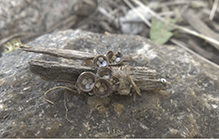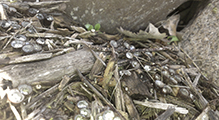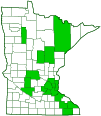Common Bird’s Nest
(Crucibulum laeve)
Conservation • Description • Habitat • Ecology • Distribution • Taxonomy
Conservation Status |
|
|||||||
| IUCN Red List | not listed |
|||||||
| NatureServe | not listed |
|||||||
| Minnesota | not listed |
|||||||
Description |
||
Common Bird’s Nest occurs on all continents except Greenland and Antarctica. It may be the most common bird’s nest fungus in Canada and the northern two-thirds of the United States. Although common, its small size makes it difficult to see. It obtains its nutrients from dead and decaying organic matter (saprobic). It grows scattered or in groups on sticks, wood chips, humus, vegetable debris, and manure. It does not grow on larger logs or on the ground. It is called “bird’s nest” because mature specimens have the appearance of a bird’s nest with several eggs. The fruiting body is a very small, stalkless, single-layered, hollow, bowl-shaped “nest” containing several tiny, egg-like capsules. It is cushion-shaped when it first appears. As it grows it becomes cup-shaped, narrow at the base, and widely flared at the more or less circular rim. When young, the outer surface is yellowish, densely covered with velvety or shaggy hairs, and topped with a thin, hairy, yellowish-tan lid. At maturity the nest is 3 ⁄16″ to ½″ tall and about as wide at the mouth. The outer surface sloughs off leaving a hairless, brown, shiny surface. The lid ruptures and disappears revealing several capsules and a smooth, white to silvery-gray or pale cinnamon-colored inner surface. There are no tooth-like projections on the rim. The eggs (peridioles) are circular, flattened, 1 ⁄32″ to 1 ⁄16″ (1 to 2 mm) in diameter, and white to grayish-white or very slightly buff. They are attached to the side of the nest by a long, thin, elastic, white cord that can be seen only with a hand lens, a needle, and patience. The eggs are disbursed by raindrops and wind. Common Bird’s Nest may be edible but is too small and tough to be worth the effort. |
||
Similar Species |
||
Habitat and Hosts |
||
|
||
Ecology |
||
Season |
||
Spring through fall |
||
Distribution |
||||
|
Sources |
|||
| 11/18/2022 | ||||
Occurrence |
||||
Very common and very widespread |
||||
Taxonomy |
|||
| Kingdom | Fungi (fungi) | ||
| Subkingdom | Dikarya | ||
| Phylum | Basidiomycota (club fungi) | ||
| Subphylum | Agaricomycotina (jelly fungi, yeasts, and mushrooms) | ||
| Class | Agaricomycetes (mushrooms, bracket fungi, puffballs, and allies) | ||
| Subclass | Agaricomycetidae | ||
| Order | Agaricales (common gilled mushrooms and allies) | ||
| Suborder | Agaricineae | ||
| Family | Nidulariaceae (bird’s nest fungi) | ||
| Genus | Crucibulum | ||
Synonyms |
|||
Crucibulum vulgare Cyathella laevis Nidularia laevis Peziza laevis |
|||
Common Names |
|||
Common Bird’s Nest Common Bird’s Nest Fungus |
|||
Glossary
Saprobic
A term often used for saprotrophic fungi. Referring to fungi that obtain their nutrients from decayed organic matter.
Visitor Photos |
|||||
Share your photo of this fungus. |
|||||
| This button not working for you? Simply email us at info@MinnesotaSeasons.com. Attach one or more photos and, if you like, a caption. |
|||||
Ginger Halverson |
|||||
"The Nidulariaceae ('nidulus' - small nest) are a family of fungi in the order Agaricales. Commonly known as the bird's nest fungi," — Wikipedia |
 |
||||
 |
|||||
MinnesotaSeasons.com Photos |
|||||
|
|||||

Slideshows |
||

Visitor Videos |
|||
Share your video of this mammal. |
|||
| This button not working for you? Simply email us at info@MinnesotaSeasons.com. Attach a video, a YouTube link, or a cloud storage link. |
|||
Other Videos |
|||

Visitor Sightings |
|||||
Report a sighting of this fungus. |
|||||
| This button not working for you? Simply email us at info@MinnesotaSeasons.com. Be sure to include a location. |
|||||
| Ginger Halverson May 2015 |
Location: Found these in May 2015 on my old wood mulch. Near Sunburg MN. "The Nidulariaceae ('nidulus' - small nest) are a family of fungi in the order Agaricales. Commonly known as the bird's nest fungi," |
||||
MinnesotaSeasons.com Sightings |
|||||
|
|||||

Created: 1/19/2018
Last Updated:

